Case Study: Global Wine Wars - New World Challenges Old World
VerifiedAdded on 2022/08/22
|8
|2379
|29
Case Study
AI Summary
This case study analyzes the "Global Wine Wars," focusing on the challenges posed by New World wine producers to the traditional Old World producers. Using the Resource-based View and the Institutions-based View of strategy, the analysis examines how factors such as technological advancements, evolving marketing strategies, and favorable institutional environments have allowed New World producers, like those in Australia and the USA, to gain a competitive edge. The study highlights the impact of regulations, classifications, and evolving market dynamics. The assignment explores the resources and capabilities that enabled New World producers to capitalize on industry changes, simultaneously identifying the threats faced by Old World producers. The paper discusses the shift from traditional practices to more market-oriented approaches and the influence of capitalism, concluding that New World producers are poised to lead the global wine market due to their adaptability and strategic advantages.
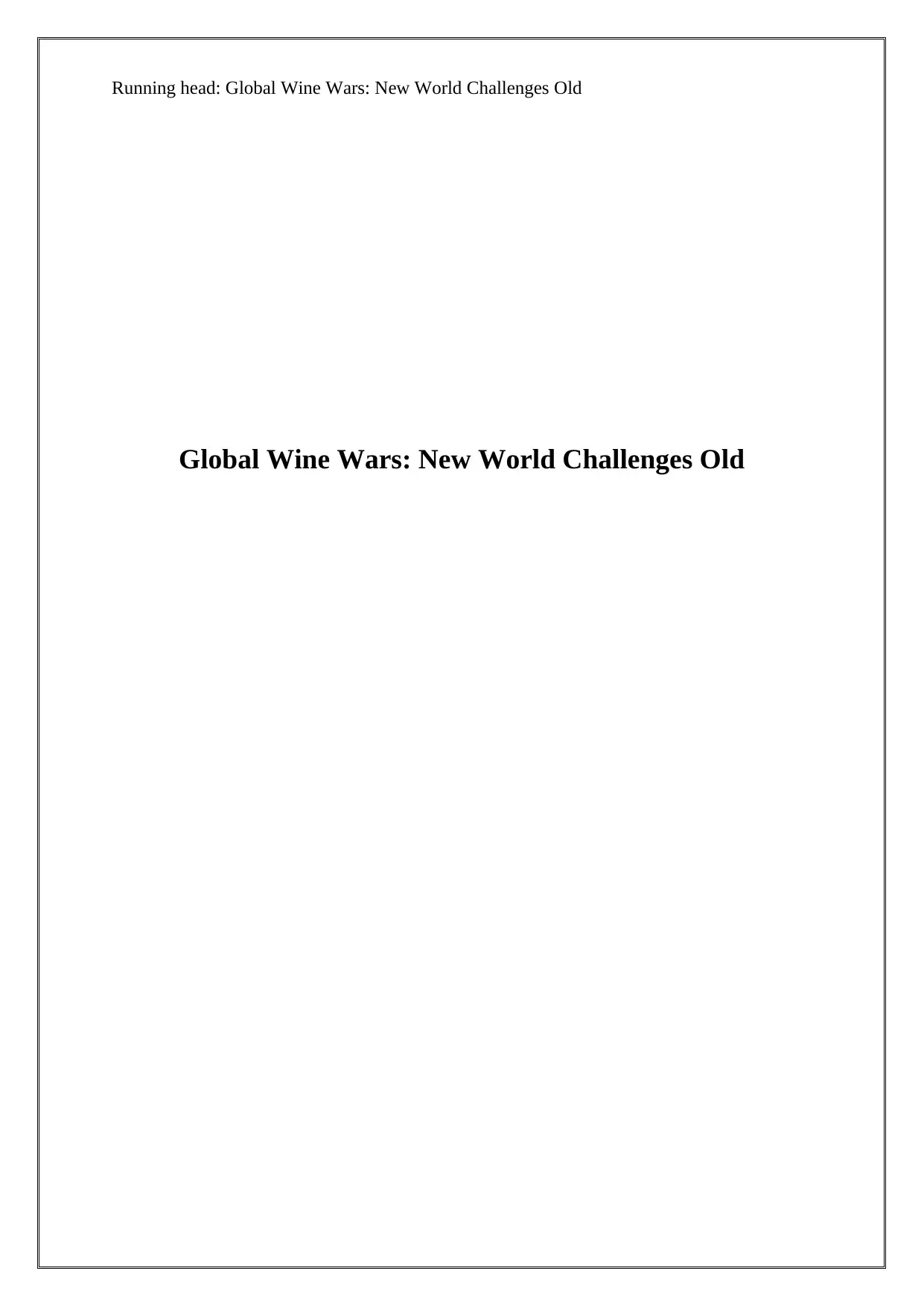
Running head: Global Wine Wars: New World Challenges Old
Global Wine Wars: New World Challenges Old
Global Wine Wars: New World Challenges Old
Paraphrase This Document
Need a fresh take? Get an instant paraphrase of this document with our AI Paraphraser
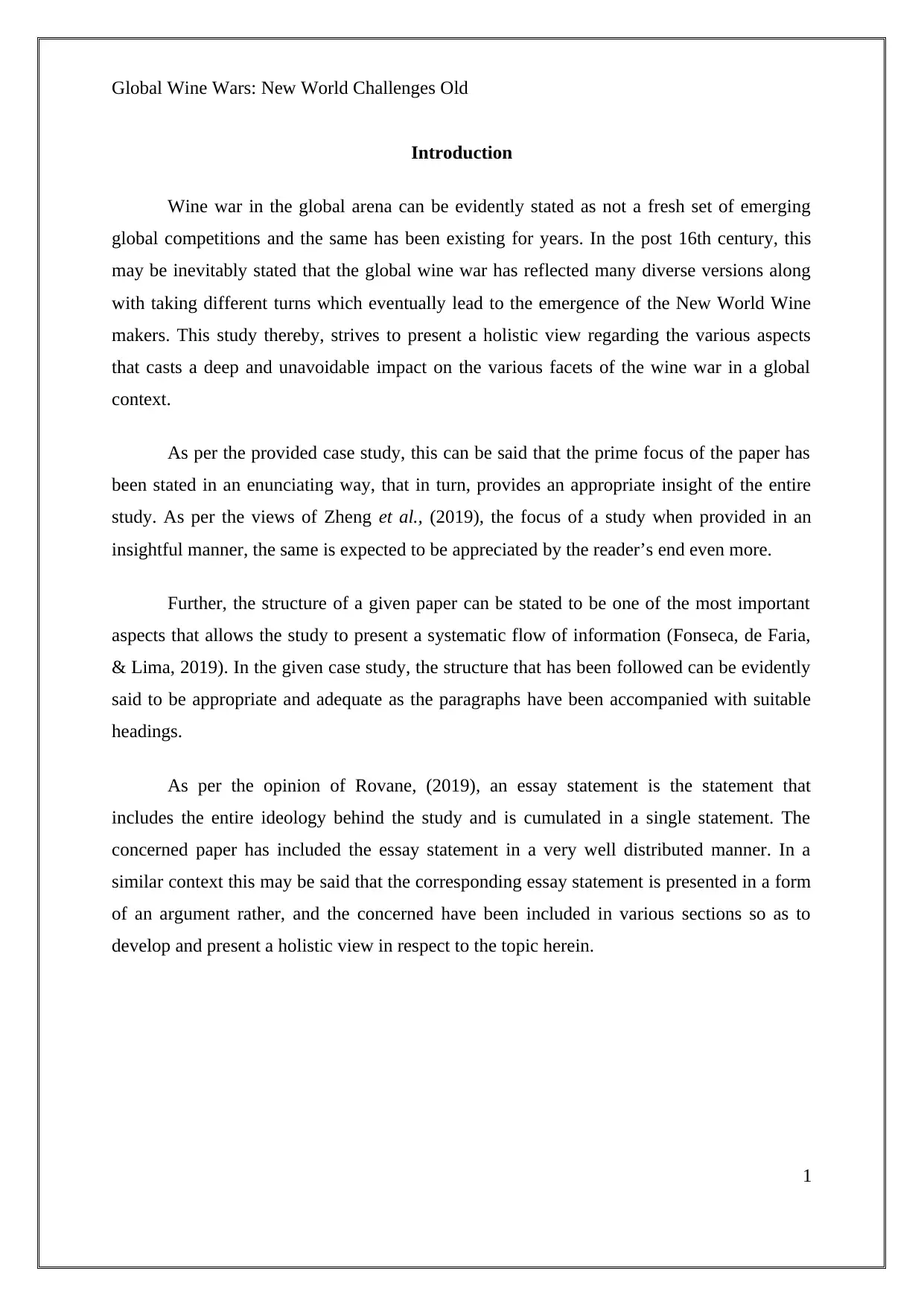
Global Wine Wars: New World Challenges Old
Introduction
Wine war in the global arena can be evidently stated as not a fresh set of emerging
global competitions and the same has been existing for years. In the post 16th century, this
may be inevitably stated that the global wine war has reflected many diverse versions along
with taking different turns which eventually lead to the emergence of the New World Wine
makers. This study thereby, strives to present a holistic view regarding the various aspects
that casts a deep and unavoidable impact on the various facets of the wine war in a global
context.
As per the provided case study, this can be said that the prime focus of the paper has
been stated in an enunciating way, that in turn, provides an appropriate insight of the entire
study. As per the views of Zheng et al., (2019), the focus of a study when provided in an
insightful manner, the same is expected to be appreciated by the reader’s end even more.
Further, the structure of a given paper can be stated to be one of the most important
aspects that allows the study to present a systematic flow of information (Fonseca, de Faria,
& Lima, 2019). In the given case study, the structure that has been followed can be evidently
said to be appropriate and adequate as the paragraphs have been accompanied with suitable
headings.
As per the opinion of Rovane, (2019), an essay statement is the statement that
includes the entire ideology behind the study and is cumulated in a single statement. The
concerned paper has included the essay statement in a very well distributed manner. In a
similar context this may be said that the corresponding essay statement is presented in a form
of an argument rather, and the concerned have been included in various sections so as to
develop and present a holistic view in respect to the topic herein.
1
Introduction
Wine war in the global arena can be evidently stated as not a fresh set of emerging
global competitions and the same has been existing for years. In the post 16th century, this
may be inevitably stated that the global wine war has reflected many diverse versions along
with taking different turns which eventually lead to the emergence of the New World Wine
makers. This study thereby, strives to present a holistic view regarding the various aspects
that casts a deep and unavoidable impact on the various facets of the wine war in a global
context.
As per the provided case study, this can be said that the prime focus of the paper has
been stated in an enunciating way, that in turn, provides an appropriate insight of the entire
study. As per the views of Zheng et al., (2019), the focus of a study when provided in an
insightful manner, the same is expected to be appreciated by the reader’s end even more.
Further, the structure of a given paper can be stated to be one of the most important
aspects that allows the study to present a systematic flow of information (Fonseca, de Faria,
& Lima, 2019). In the given case study, the structure that has been followed can be evidently
said to be appropriate and adequate as the paragraphs have been accompanied with suitable
headings.
As per the opinion of Rovane, (2019), an essay statement is the statement that
includes the entire ideology behind the study and is cumulated in a single statement. The
concerned paper has included the essay statement in a very well distributed manner. In a
similar context this may be said that the corresponding essay statement is presented in a form
of an argument rather, and the concerned have been included in various sections so as to
develop and present a holistic view in respect to the topic herein.
1
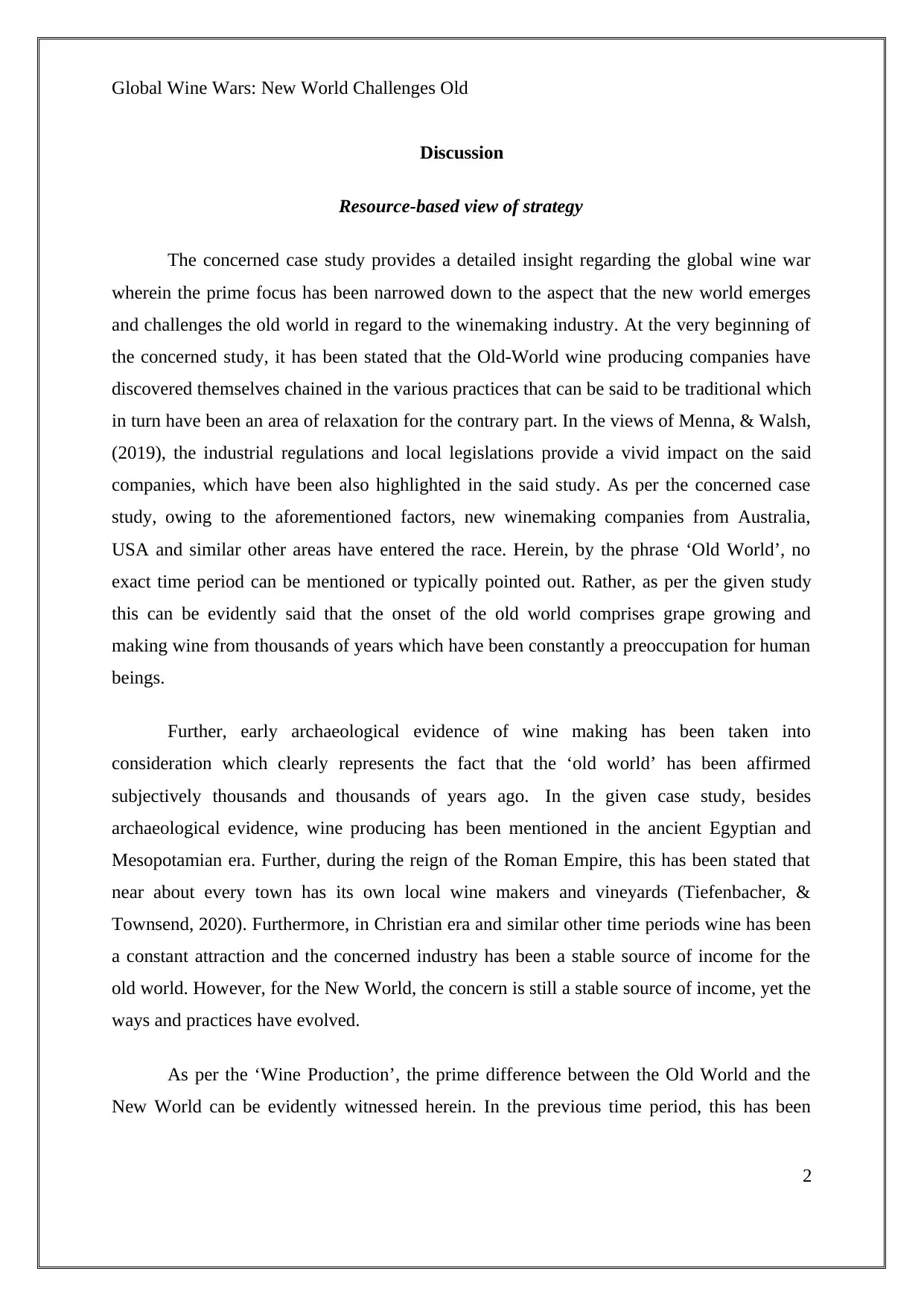
Global Wine Wars: New World Challenges Old
Discussion
Resource-based view of strategy
The concerned case study provides a detailed insight regarding the global wine war
wherein the prime focus has been narrowed down to the aspect that the new world emerges
and challenges the old world in regard to the winemaking industry. At the very beginning of
the concerned study, it has been stated that the Old-World wine producing companies have
discovered themselves chained in the various practices that can be said to be traditional which
in turn have been an area of relaxation for the contrary part. In the views of Menna, & Walsh,
(2019), the industrial regulations and local legislations provide a vivid impact on the said
companies, which have been also highlighted in the said study. As per the concerned case
study, owing to the aforementioned factors, new winemaking companies from Australia,
USA and similar other areas have entered the race. Herein, by the phrase ‘Old World’, no
exact time period can be mentioned or typically pointed out. Rather, as per the given study
this can be evidently said that the onset of the old world comprises grape growing and
making wine from thousands of years which have been constantly a preoccupation for human
beings.
Further, early archaeological evidence of wine making has been taken into
consideration which clearly represents the fact that the ‘old world’ has been affirmed
subjectively thousands and thousands of years ago. In the given case study, besides
archaeological evidence, wine producing has been mentioned in the ancient Egyptian and
Mesopotamian era. Further, during the reign of the Roman Empire, this has been stated that
near about every town has its own local wine makers and vineyards (Tiefenbacher, &
Townsend, 2020). Furthermore, in Christian era and similar other time periods wine has been
a constant attraction and the concerned industry has been a stable source of income for the
old world. However, for the New World, the concern is still a stable source of income, yet the
ways and practices have evolved.
As per the ‘Wine Production’, the prime difference between the Old World and the
New World can be evidently witnessed herein. In the previous time period, this has been
2
Discussion
Resource-based view of strategy
The concerned case study provides a detailed insight regarding the global wine war
wherein the prime focus has been narrowed down to the aspect that the new world emerges
and challenges the old world in regard to the winemaking industry. At the very beginning of
the concerned study, it has been stated that the Old-World wine producing companies have
discovered themselves chained in the various practices that can be said to be traditional which
in turn have been an area of relaxation for the contrary part. In the views of Menna, & Walsh,
(2019), the industrial regulations and local legislations provide a vivid impact on the said
companies, which have been also highlighted in the said study. As per the concerned case
study, owing to the aforementioned factors, new winemaking companies from Australia,
USA and similar other areas have entered the race. Herein, by the phrase ‘Old World’, no
exact time period can be mentioned or typically pointed out. Rather, as per the given study
this can be evidently said that the onset of the old world comprises grape growing and
making wine from thousands of years which have been constantly a preoccupation for human
beings.
Further, early archaeological evidence of wine making has been taken into
consideration which clearly represents the fact that the ‘old world’ has been affirmed
subjectively thousands and thousands of years ago. In the given case study, besides
archaeological evidence, wine producing has been mentioned in the ancient Egyptian and
Mesopotamian era. Further, during the reign of the Roman Empire, this has been stated that
near about every town has its own local wine makers and vineyards (Tiefenbacher, &
Townsend, 2020). Furthermore, in Christian era and similar other time periods wine has been
a constant attraction and the concerned industry has been a stable source of income for the
old world. However, for the New World, the concern is still a stable source of income, yet the
ways and practices have evolved.
As per the ‘Wine Production’, the prime difference between the Old World and the
New World can be evidently witnessed herein. In the previous time period, this has been
2
⊘ This is a preview!⊘
Do you want full access?
Subscribe today to unlock all pages.

Trusted by 1+ million students worldwide
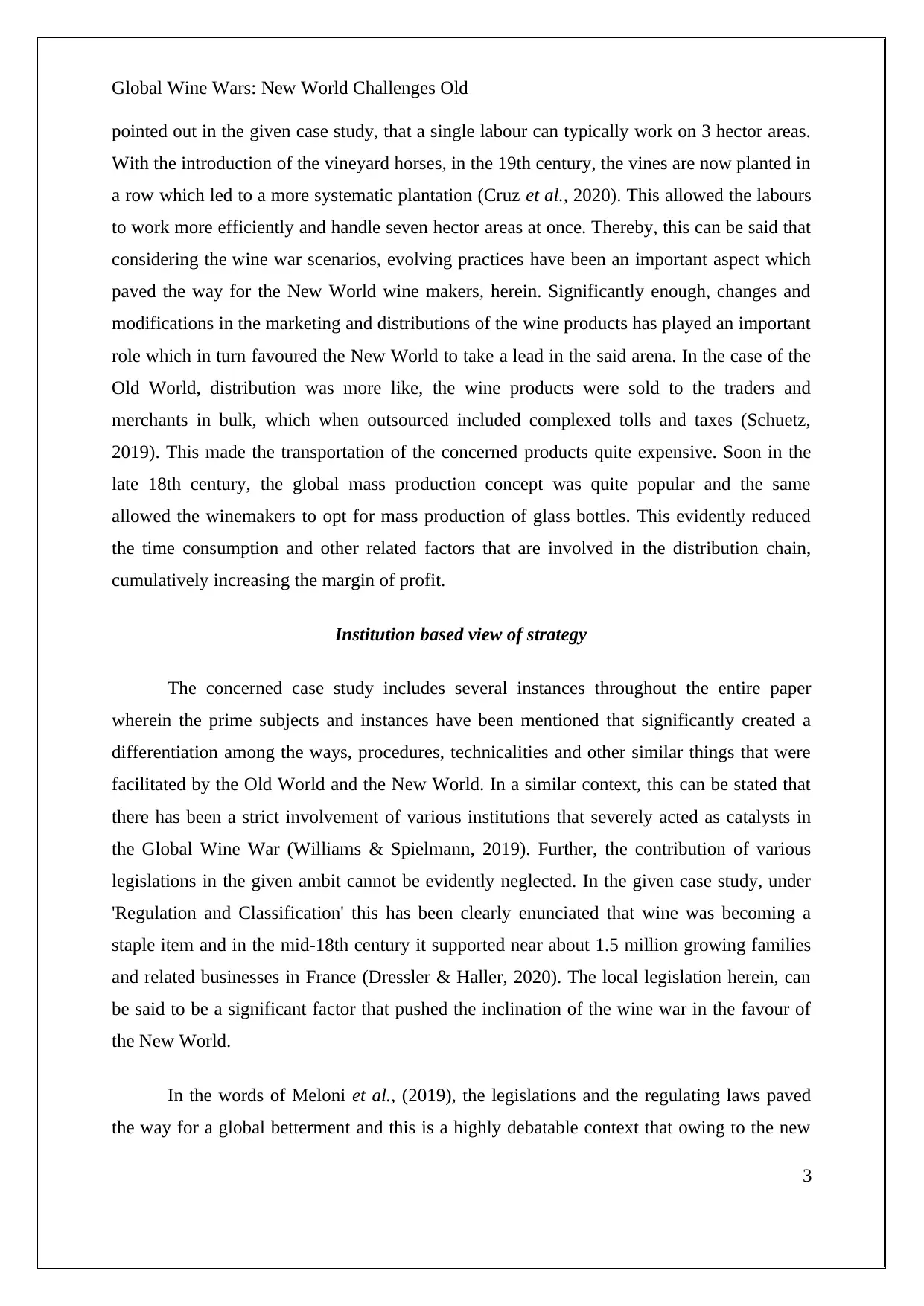
Global Wine Wars: New World Challenges Old
pointed out in the given case study, that a single labour can typically work on 3 hector areas.
With the introduction of the vineyard horses, in the 19th century, the vines are now planted in
a row which led to a more systematic plantation (Cruz et al., 2020). This allowed the labours
to work more efficiently and handle seven hector areas at once. Thereby, this can be said that
considering the wine war scenarios, evolving practices have been an important aspect which
paved the way for the New World wine makers, herein. Significantly enough, changes and
modifications in the marketing and distributions of the wine products has played an important
role which in turn favoured the New World to take a lead in the said arena. In the case of the
Old World, distribution was more like, the wine products were sold to the traders and
merchants in bulk, which when outsourced included complexed tolls and taxes (Schuetz,
2019). This made the transportation of the concerned products quite expensive. Soon in the
late 18th century, the global mass production concept was quite popular and the same
allowed the winemakers to opt for mass production of glass bottles. This evidently reduced
the time consumption and other related factors that are involved in the distribution chain,
cumulatively increasing the margin of profit.
Institution based view of strategy
The concerned case study includes several instances throughout the entire paper
wherein the prime subjects and instances have been mentioned that significantly created a
differentiation among the ways, procedures, technicalities and other similar things that were
facilitated by the Old World and the New World. In a similar context, this can be stated that
there has been a strict involvement of various institutions that severely acted as catalysts in
the Global Wine War (Williams & Spielmann, 2019). Further, the contribution of various
legislations in the given ambit cannot be evidently neglected. In the given case study, under
'Regulation and Classification' this has been clearly enunciated that wine was becoming a
staple item and in the mid-18th century it supported near about 1.5 million growing families
and related businesses in France (Dressler & Haller, 2020). The local legislation herein, can
be said to be a significant factor that pushed the inclination of the wine war in the favour of
the New World.
In the words of Meloni et al., (2019), the legislations and the regulating laws paved
the way for a global betterment and this is a highly debatable context that owing to the new
3
pointed out in the given case study, that a single labour can typically work on 3 hector areas.
With the introduction of the vineyard horses, in the 19th century, the vines are now planted in
a row which led to a more systematic plantation (Cruz et al., 2020). This allowed the labours
to work more efficiently and handle seven hector areas at once. Thereby, this can be said that
considering the wine war scenarios, evolving practices have been an important aspect which
paved the way for the New World wine makers, herein. Significantly enough, changes and
modifications in the marketing and distributions of the wine products has played an important
role which in turn favoured the New World to take a lead in the said arena. In the case of the
Old World, distribution was more like, the wine products were sold to the traders and
merchants in bulk, which when outsourced included complexed tolls and taxes (Schuetz,
2019). This made the transportation of the concerned products quite expensive. Soon in the
late 18th century, the global mass production concept was quite popular and the same
allowed the winemakers to opt for mass production of glass bottles. This evidently reduced
the time consumption and other related factors that are involved in the distribution chain,
cumulatively increasing the margin of profit.
Institution based view of strategy
The concerned case study includes several instances throughout the entire paper
wherein the prime subjects and instances have been mentioned that significantly created a
differentiation among the ways, procedures, technicalities and other similar things that were
facilitated by the Old World and the New World. In a similar context, this can be stated that
there has been a strict involvement of various institutions that severely acted as catalysts in
the Global Wine War (Williams & Spielmann, 2019). Further, the contribution of various
legislations in the given ambit cannot be evidently neglected. In the given case study, under
'Regulation and Classification' this has been clearly enunciated that wine was becoming a
staple item and in the mid-18th century it supported near about 1.5 million growing families
and related businesses in France (Dressler & Haller, 2020). The local legislation herein, can
be said to be a significant factor that pushed the inclination of the wine war in the favour of
the New World.
In the words of Meloni et al., (2019), the legislations and the regulating laws paved
the way for a global betterment and this is a highly debatable context that owing to the new
3
Paraphrase This Document
Need a fresh take? Get an instant paraphrase of this document with our AI Paraphraser
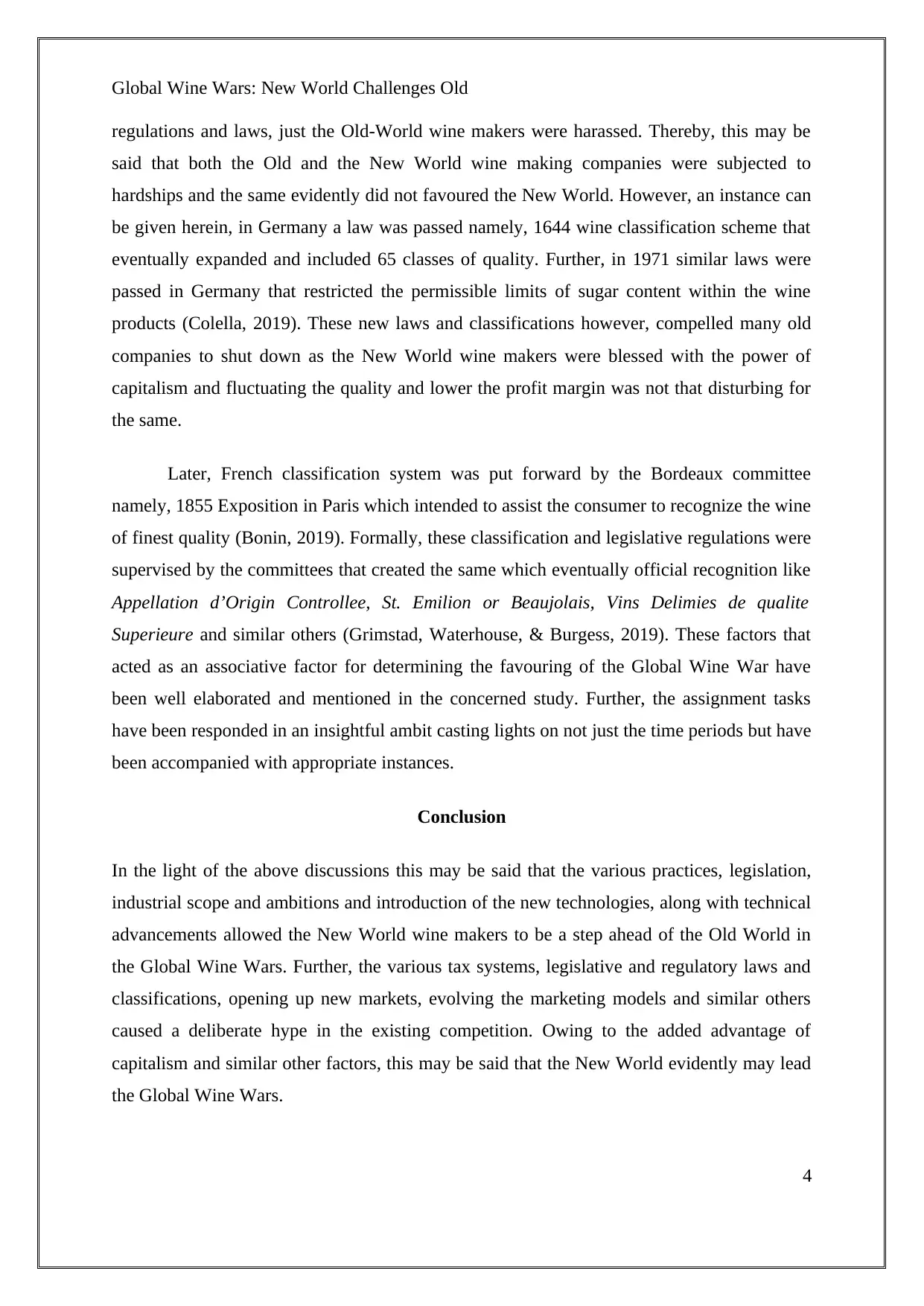
Global Wine Wars: New World Challenges Old
regulations and laws, just the Old-World wine makers were harassed. Thereby, this may be
said that both the Old and the New World wine making companies were subjected to
hardships and the same evidently did not favoured the New World. However, an instance can
be given herein, in Germany a law was passed namely, 1644 wine classification scheme that
eventually expanded and included 65 classes of quality. Further, in 1971 similar laws were
passed in Germany that restricted the permissible limits of sugar content within the wine
products (Colella, 2019). These new laws and classifications however, compelled many old
companies to shut down as the New World wine makers were blessed with the power of
capitalism and fluctuating the quality and lower the profit margin was not that disturbing for
the same.
Later, French classification system was put forward by the Bordeaux committee
namely, 1855 Exposition in Paris which intended to assist the consumer to recognize the wine
of finest quality (Bonin, 2019). Formally, these classification and legislative regulations were
supervised by the committees that created the same which eventually official recognition like
Appellation d’Origin Controllee, St. Emilion or Beaujolais, Vins Delimies de qualite
Superieure and similar others (Grimstad, Waterhouse, & Burgess, 2019). These factors that
acted as an associative factor for determining the favouring of the Global Wine War have
been well elaborated and mentioned in the concerned study. Further, the assignment tasks
have been responded in an insightful ambit casting lights on not just the time periods but have
been accompanied with appropriate instances.
Conclusion
In the light of the above discussions this may be said that the various practices, legislation,
industrial scope and ambitions and introduction of the new technologies, along with technical
advancements allowed the New World wine makers to be a step ahead of the Old World in
the Global Wine Wars. Further, the various tax systems, legislative and regulatory laws and
classifications, opening up new markets, evolving the marketing models and similar others
caused a deliberate hype in the existing competition. Owing to the added advantage of
capitalism and similar other factors, this may be said that the New World evidently may lead
the Global Wine Wars.
4
regulations and laws, just the Old-World wine makers were harassed. Thereby, this may be
said that both the Old and the New World wine making companies were subjected to
hardships and the same evidently did not favoured the New World. However, an instance can
be given herein, in Germany a law was passed namely, 1644 wine classification scheme that
eventually expanded and included 65 classes of quality. Further, in 1971 similar laws were
passed in Germany that restricted the permissible limits of sugar content within the wine
products (Colella, 2019). These new laws and classifications however, compelled many old
companies to shut down as the New World wine makers were blessed with the power of
capitalism and fluctuating the quality and lower the profit margin was not that disturbing for
the same.
Later, French classification system was put forward by the Bordeaux committee
namely, 1855 Exposition in Paris which intended to assist the consumer to recognize the wine
of finest quality (Bonin, 2019). Formally, these classification and legislative regulations were
supervised by the committees that created the same which eventually official recognition like
Appellation d’Origin Controllee, St. Emilion or Beaujolais, Vins Delimies de qualite
Superieure and similar others (Grimstad, Waterhouse, & Burgess, 2019). These factors that
acted as an associative factor for determining the favouring of the Global Wine War have
been well elaborated and mentioned in the concerned study. Further, the assignment tasks
have been responded in an insightful ambit casting lights on not just the time periods but have
been accompanied with appropriate instances.
Conclusion
In the light of the above discussions this may be said that the various practices, legislation,
industrial scope and ambitions and introduction of the new technologies, along with technical
advancements allowed the New World wine makers to be a step ahead of the Old World in
the Global Wine Wars. Further, the various tax systems, legislative and regulatory laws and
classifications, opening up new markets, evolving the marketing models and similar others
caused a deliberate hype in the existing competition. Owing to the added advantage of
capitalism and similar other factors, this may be said that the New World evidently may lead
the Global Wine Wars.
4
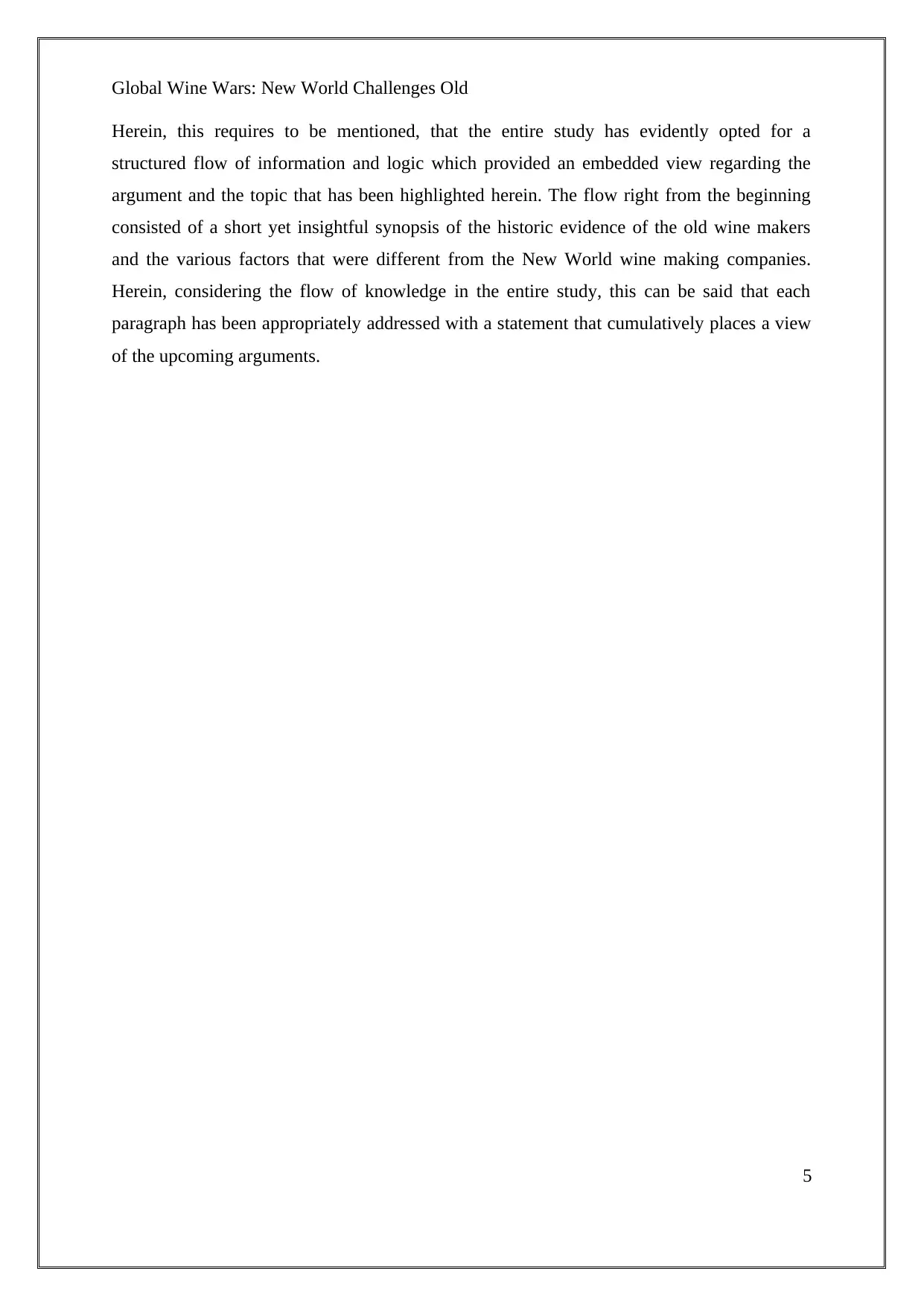
Global Wine Wars: New World Challenges Old
Herein, this requires to be mentioned, that the entire study has evidently opted for a
structured flow of information and logic which provided an embedded view regarding the
argument and the topic that has been highlighted herein. The flow right from the beginning
consisted of a short yet insightful synopsis of the historic evidence of the old wine makers
and the various factors that were different from the New World wine making companies.
Herein, considering the flow of knowledge in the entire study, this can be said that each
paragraph has been appropriately addressed with a statement that cumulatively places a view
of the upcoming arguments.
5
Herein, this requires to be mentioned, that the entire study has evidently opted for a
structured flow of information and logic which provided an embedded view regarding the
argument and the topic that has been highlighted herein. The flow right from the beginning
consisted of a short yet insightful synopsis of the historic evidence of the old wine makers
and the various factors that were different from the New World wine making companies.
Herein, considering the flow of knowledge in the entire study, this can be said that each
paragraph has been appropriately addressed with a statement that cumulatively places a view
of the upcoming arguments.
5
⊘ This is a preview!⊘
Do you want full access?
Subscribe today to unlock all pages.

Trusted by 1+ million students worldwide
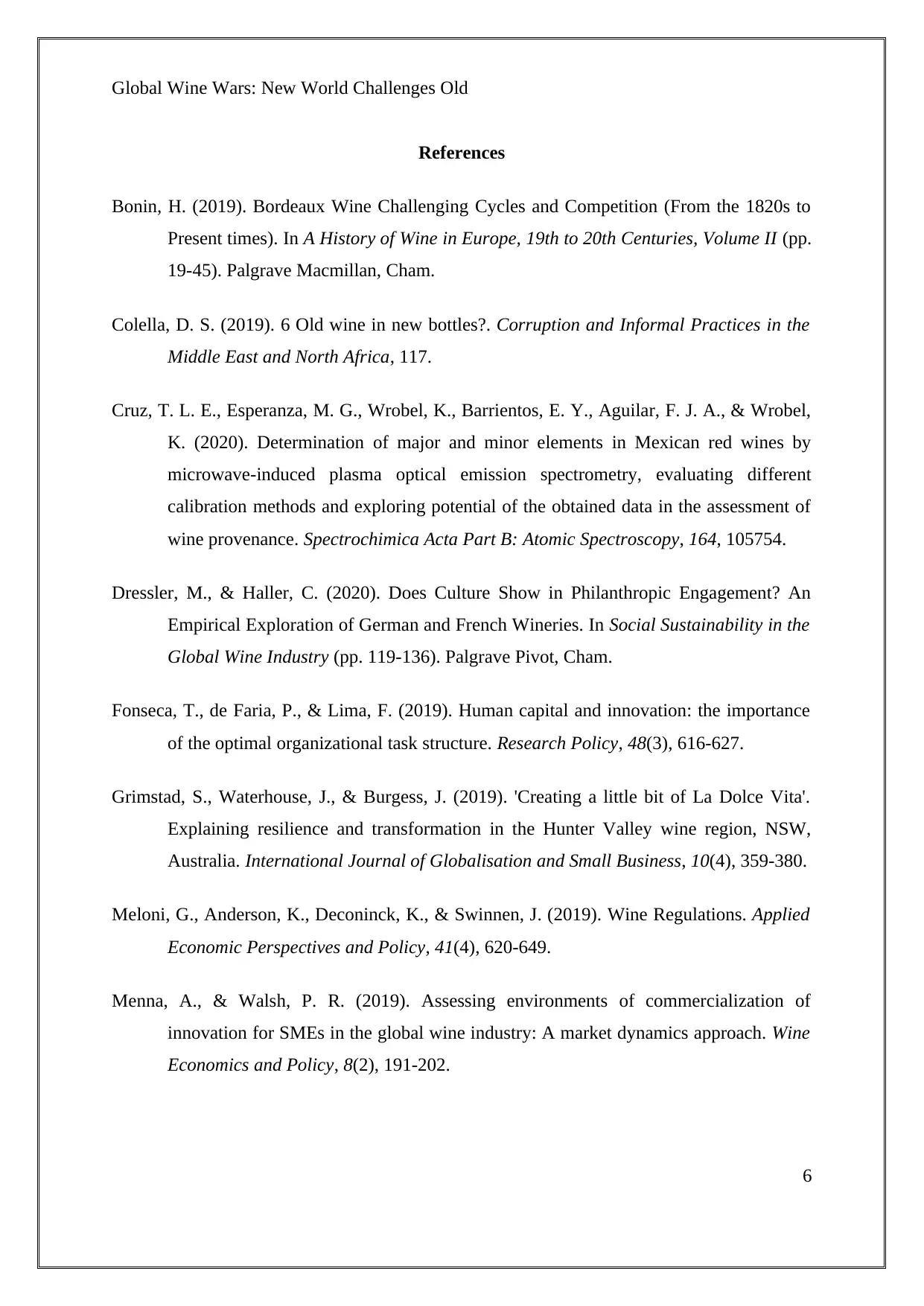
Global Wine Wars: New World Challenges Old
References
Bonin, H. (2019). Bordeaux Wine Challenging Cycles and Competition (From the 1820s to
Present times). In A History of Wine in Europe, 19th to 20th Centuries, Volume II (pp.
19-45). Palgrave Macmillan, Cham.
Colella, D. S. (2019). 6 Old wine in new bottles?. Corruption and Informal Practices in the
Middle East and North Africa, 117.
Cruz, T. L. E., Esperanza, M. G., Wrobel, K., Barrientos, E. Y., Aguilar, F. J. A., & Wrobel,
K. (2020). Determination of major and minor elements in Mexican red wines by
microwave-induced plasma optical emission spectrometry, evaluating different
calibration methods and exploring potential of the obtained data in the assessment of
wine provenance. Spectrochimica Acta Part B: Atomic Spectroscopy, 164, 105754.
Dressler, M., & Haller, C. (2020). Does Culture Show in Philanthropic Engagement? An
Empirical Exploration of German and French Wineries. In Social Sustainability in the
Global Wine Industry (pp. 119-136). Palgrave Pivot, Cham.
Fonseca, T., de Faria, P., & Lima, F. (2019). Human capital and innovation: the importance
of the optimal organizational task structure. Research Policy, 48(3), 616-627.
Grimstad, S., Waterhouse, J., & Burgess, J. (2019). 'Creating a little bit of La Dolce Vita'.
Explaining resilience and transformation in the Hunter Valley wine region, NSW,
Australia. International Journal of Globalisation and Small Business, 10(4), 359-380.
Meloni, G., Anderson, K., Deconinck, K., & Swinnen, J. (2019). Wine Regulations. Applied
Economic Perspectives and Policy, 41(4), 620-649.
Menna, A., & Walsh, P. R. (2019). Assessing environments of commercialization of
innovation for SMEs in the global wine industry: A market dynamics approach. Wine
Economics and Policy, 8(2), 191-202.
6
References
Bonin, H. (2019). Bordeaux Wine Challenging Cycles and Competition (From the 1820s to
Present times). In A History of Wine in Europe, 19th to 20th Centuries, Volume II (pp.
19-45). Palgrave Macmillan, Cham.
Colella, D. S. (2019). 6 Old wine in new bottles?. Corruption and Informal Practices in the
Middle East and North Africa, 117.
Cruz, T. L. E., Esperanza, M. G., Wrobel, K., Barrientos, E. Y., Aguilar, F. J. A., & Wrobel,
K. (2020). Determination of major and minor elements in Mexican red wines by
microwave-induced plasma optical emission spectrometry, evaluating different
calibration methods and exploring potential of the obtained data in the assessment of
wine provenance. Spectrochimica Acta Part B: Atomic Spectroscopy, 164, 105754.
Dressler, M., & Haller, C. (2020). Does Culture Show in Philanthropic Engagement? An
Empirical Exploration of German and French Wineries. In Social Sustainability in the
Global Wine Industry (pp. 119-136). Palgrave Pivot, Cham.
Fonseca, T., de Faria, P., & Lima, F. (2019). Human capital and innovation: the importance
of the optimal organizational task structure. Research Policy, 48(3), 616-627.
Grimstad, S., Waterhouse, J., & Burgess, J. (2019). 'Creating a little bit of La Dolce Vita'.
Explaining resilience and transformation in the Hunter Valley wine region, NSW,
Australia. International Journal of Globalisation and Small Business, 10(4), 359-380.
Meloni, G., Anderson, K., Deconinck, K., & Swinnen, J. (2019). Wine Regulations. Applied
Economic Perspectives and Policy, 41(4), 620-649.
Menna, A., & Walsh, P. R. (2019). Assessing environments of commercialization of
innovation for SMEs in the global wine industry: A market dynamics approach. Wine
Economics and Policy, 8(2), 191-202.
6
Paraphrase This Document
Need a fresh take? Get an instant paraphrase of this document with our AI Paraphraser
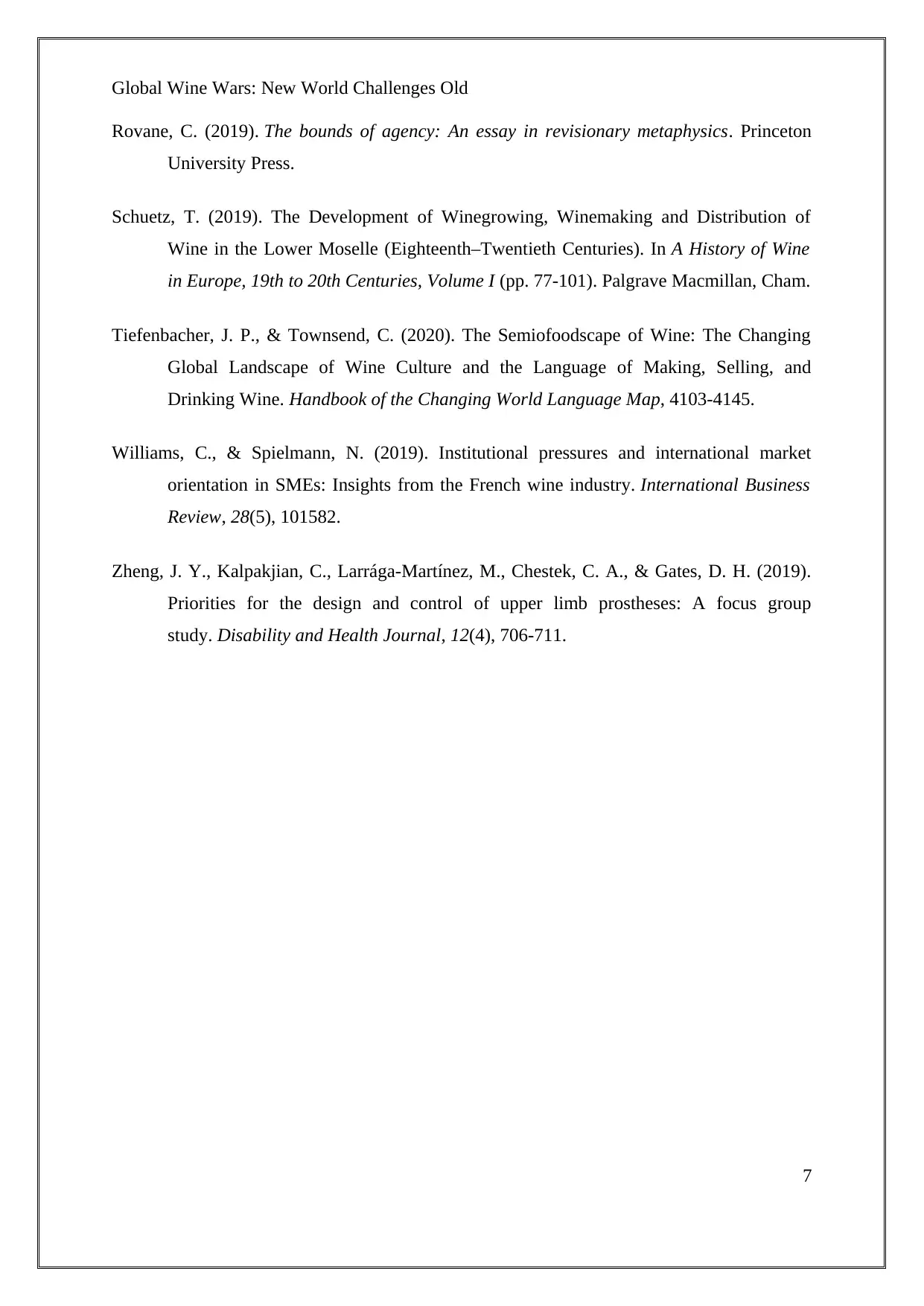
Global Wine Wars: New World Challenges Old
Rovane, C. (2019). The bounds of agency: An essay in revisionary metaphysics. Princeton
University Press.
Schuetz, T. (2019). The Development of Winegrowing, Winemaking and Distribution of
Wine in the Lower Moselle (Eighteenth–Twentieth Centuries). In A History of Wine
in Europe, 19th to 20th Centuries, Volume I (pp. 77-101). Palgrave Macmillan, Cham.
Tiefenbacher, J. P., & Townsend, C. (2020). The Semiofoodscape of Wine: The Changing
Global Landscape of Wine Culture and the Language of Making, Selling, and
Drinking Wine. Handbook of the Changing World Language Map, 4103-4145.
Williams, C., & Spielmann, N. (2019). Institutional pressures and international market
orientation in SMEs: Insights from the French wine industry. International Business
Review, 28(5), 101582.
Zheng, J. Y., Kalpakjian, C., Larrága-Martínez, M., Chestek, C. A., & Gates, D. H. (2019).
Priorities for the design and control of upper limb prostheses: A focus group
study. Disability and Health Journal, 12(4), 706-711.
7
Rovane, C. (2019). The bounds of agency: An essay in revisionary metaphysics. Princeton
University Press.
Schuetz, T. (2019). The Development of Winegrowing, Winemaking and Distribution of
Wine in the Lower Moselle (Eighteenth–Twentieth Centuries). In A History of Wine
in Europe, 19th to 20th Centuries, Volume I (pp. 77-101). Palgrave Macmillan, Cham.
Tiefenbacher, J. P., & Townsend, C. (2020). The Semiofoodscape of Wine: The Changing
Global Landscape of Wine Culture and the Language of Making, Selling, and
Drinking Wine. Handbook of the Changing World Language Map, 4103-4145.
Williams, C., & Spielmann, N. (2019). Institutional pressures and international market
orientation in SMEs: Insights from the French wine industry. International Business
Review, 28(5), 101582.
Zheng, J. Y., Kalpakjian, C., Larrága-Martínez, M., Chestek, C. A., & Gates, D. H. (2019).
Priorities for the design and control of upper limb prostheses: A focus group
study. Disability and Health Journal, 12(4), 706-711.
7
1 out of 8
Related Documents
Your All-in-One AI-Powered Toolkit for Academic Success.
+13062052269
info@desklib.com
Available 24*7 on WhatsApp / Email
![[object Object]](/_next/static/media/star-bottom.7253800d.svg)
Unlock your academic potential
Copyright © 2020–2025 A2Z Services. All Rights Reserved. Developed and managed by ZUCOL.





